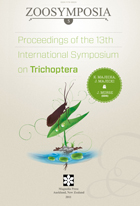Abstract
The microhabitat preference of caddisfly (Trichoptera) communities was studied in 8 types of microhabitats in a fast-flowing, medium-sized, lowland stream in Latvia. A total 36 caddisfly taxa belonging to 14 families were recorded in microhabitat samples. A PCA biplot of caddisfly taxa abundance in microhabitats showed 3 distinct caddisfly taxa groups: depositional [Limnephilidae Gen. sp., Anabolia laevis (Zetterstedt) and Lasiocephala basalis (Kolenati)], lithal [Agapetus ochripes Curtis and Psychomyia pusilla (Fabricius)], and submerged macrophyte and water moss caddisfly microhabitat communities (Ithytrichia lamellaris Eaton, Hydropsyche siltalai Döhler and Hydropsyche spp. juv.). The habitats of these groups differed in current velocity and the amount of plant detritus. All size lithal microhabitat samples were characterized by grazer and scraper dominance and a similar proportion of gatherers/collectors. Macrolithal microhabitat with Fontinalis sp. and submerged macrophyte microhabitats were rich with passive filter feeders. Functional feeding type ratios were equal, with dominance of shredders, in FPOM, CPOM in akal microhabitats. Submerged macrophyte and Fontinalis sp. provided suitable niches for higher species numbers than the other microhabitat types, whereas abundance was the highest in the lithal microhabitats with the largest particle size.

